Modern society is rapidly becoming digital, which has significantly changed the cybersecurity threats. In many cases, traditional solutions provide limited protection because as cyber threats become increasingly complex, they are insufficient. This is where Artificial Intelligence (AI) comes into play—providing cost-effective, new-entrant solutions to strengthen cybersecurity.
Cybersecurity solutions are one of the most popular applications of AI in business and security. Artificial Intelligence, ML, data analysis, and pattern recognition features make it possible to detect problems, anticipate threats, and implement reactions in real time.
In this blog, we will talk about the top 10 best AI Tools for Cybersecurity that can be used to enhance cybersecurity and help organizations, which will help you get one step ahead of the game. If you’re passionate about mastering these AI-driven technologies and advancing your career, pursuing an online cybersecurity master’s degree can equip you with the technical skills and strategic mindset needed to lead in this fast-evolving field
How AI Enhances Cybersecurity
Real-Time Threat Detection
An appealing aspect of AI in cyberspace is that this technology can analyze substantially large volumes of information in real-time. AI tools constantly analyze the traffic on the network, the behaviour of the users and log files looking for signs of threat. Unlike other approaches that rely on a signature, AI models can also detect previously unknown threats based on patterns and deviant behavior.
Automation and Response
AI tools are not only responsive but also anticipative. Most AI-driven security solutions come equipped with the capability to counter a threat by quarantining affected assets, blacklisting abusive traffic, or simply performing preprogrammed restoration operations. Response time times are greatly reduced by this automation and could reduce the threat of malware spreading in an organization’s network.
Predictive Analysis
It is important to note that, unlike traditional tools, AI tools do not only assess the threats in the present time but also those future threats. From the data collected, AI models can learn about the patterns and attack vectors, and this may well help organizations prepare their defenses in advance.
Why AI is Crucial for Cybersecurity
With time, cybersecurity threats become more pronounced than conventional methods such as firewalls and antivirus. Cybercrime is a fluid concept, and criminals are improving their tactics every year, so companies need to rely on AI in cybersecurity.
Speed and Scale
There are a few tasks that AI tools for cybersecurity cannot perform with great proficiency, as it is one of the biggest AI strengths as it is the ability to analyse large amounts of data in real-time. Artificial intelligence security systems can process network traffic, users and logs at extremely high rates, allowing the system to quickly spot threats before they can cause much harm.
Behavioural Segmentation and Pattern Identification
AI works by using machine learning to monitor the client’s activities for any suspicious activity such as login attempts, from unknown devices. This also aids in identifying “unknown” threats that are difficult to detect by ‘traditional’ tools such as relational malware, and zero-day attacks among others.
Predictive and preventive security
In threat management, AI does not only respond but also anticipates. In this case, AI gets to work on analyzing data from the past to be able to recognize areas of weakness and possible attacks so that organizations can close the loop on breaches as they happen.
Automating Incident Response
Some tasks require timely actions to be taken, such as isolating affected devices and filtering out hostile traffic. What AI does here is relieve busy security personnel of such chores.
Enhancing Threat Intelligence
AI collates information from disparate security tools to give a consolidated outlook of an organization’s security condition. This is because AI parsing of world threat feeds can lead to awareness of attackers’ techniques and enhance detection effectiveness.
Reducing Human Error
AI takes risks of human mistakes away by automating such procedures as logs analysis and threats ranking. Importantly, it supplies information on where attention should be paid and what steps should be taken as well as where potential threats are not worth investigating in detail.
Top 10 AI Tools for Cybersecurity
1. Darktrace
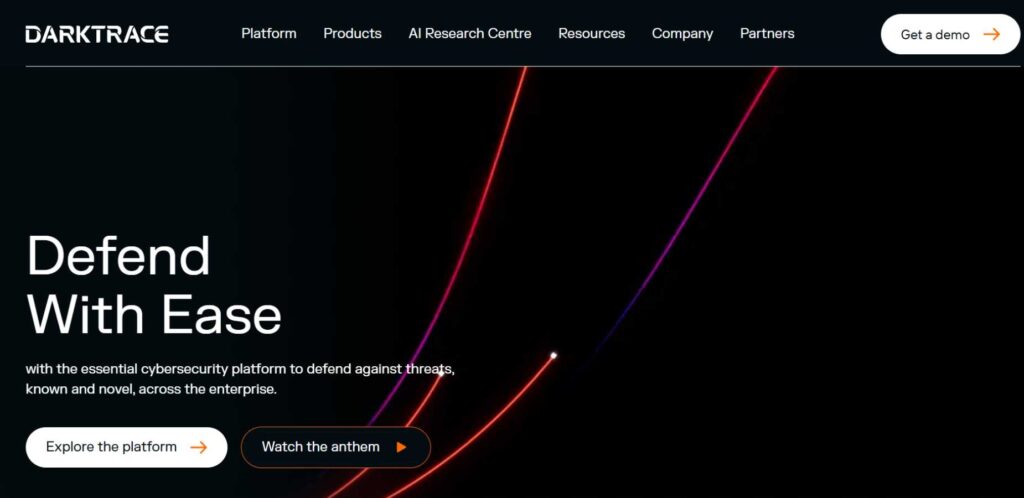
Darktrace is a global company that offers advanced technologies in cybersecurity with the use of artificial intelligence. Its platform leverages Artificial intelligence to provide autonomous protection of networks, endpoints, and the cloud from cyber threats as they happen. Meaningful artificial intelligence of Darktrace necessitates no discrete intercession to counter new threats and is more appropriate for big giant corporate scenarios.
Key Features:
- Machines’ adaptive threat manipulation and prevention
- Security that is self-managed in networks, endpoints, and the cloud
- Real-time protection of threats to the systems within an organization without the use of humans.
- Self-improving solutions capable of responding to new threats
Positives:
- Swift threat identification and use of corresponding actions
- Suits mid on the larger end of enterprise businesses.
- Reduces reliance on other people’s decisions.
Negatives:
- High costs may not be affordable for small business firms.
- Can provoke false positives in some circumstances
- May need to be set up initially and for training to be done before achieving its best operating conditions.
Best For: Mid to large enterprises seeking AI-driven cybersecurity and autonomous response.
Website: www.darktrace.com
Ratings: 4.5/5
2. CrowdStrike Falcon
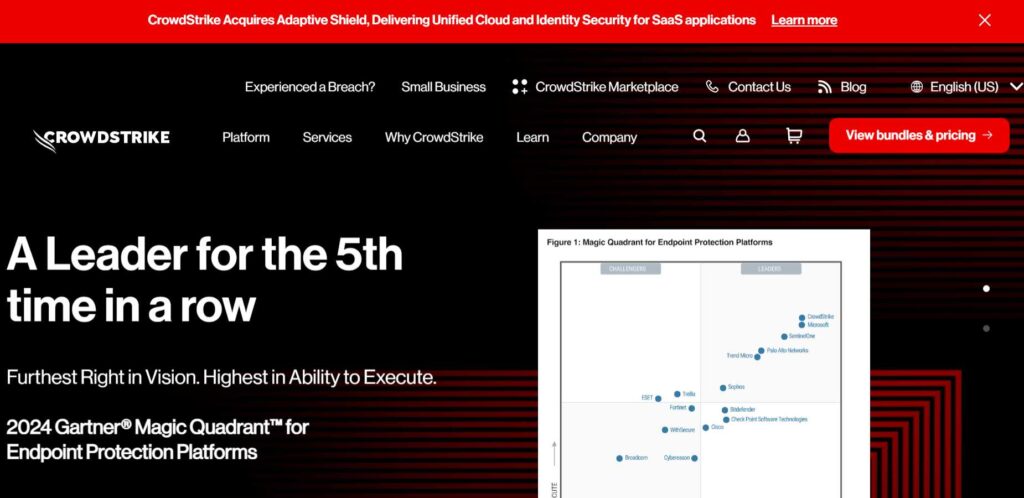
CrowdStrike Falcon is a cloud-delivered endpoint security platform that leads the market in real-time protection with AI and machine learning to catch cyber threats. Even though it is touted for its effectiveness in breach detection, CrowdStrike is also one of the ideal AI Tools for Cybersecurity, offering not only advanced threat intelligence but threat hunting and malware identification to protect devices easily.
Key Features:
- Globally integrated cloud security solution for endpoint security solution
- Threat intelligence and threat hunting at an individual level
- Virus and immediate action against them
- Protection using an approach that is based on machine learning
Positives:
- Very good protection against endpoints with cloud management capabilities
- Proactive threat hunting is crucial and has to be reported on as one of the organization’s strong points.
- Highlighted by the ability of the measures to make significant reductions in breaches.
Negatives:
- Costly to small organizations
- Can have false positives
- Demands qualified staff if the tool is to be used properly
Best For: Enterprises needing advanced endpoint protection and proactive threat intelligence.
Website: www.crowdstrike.com
Ratings: 4.7/5
3. Vectra AI
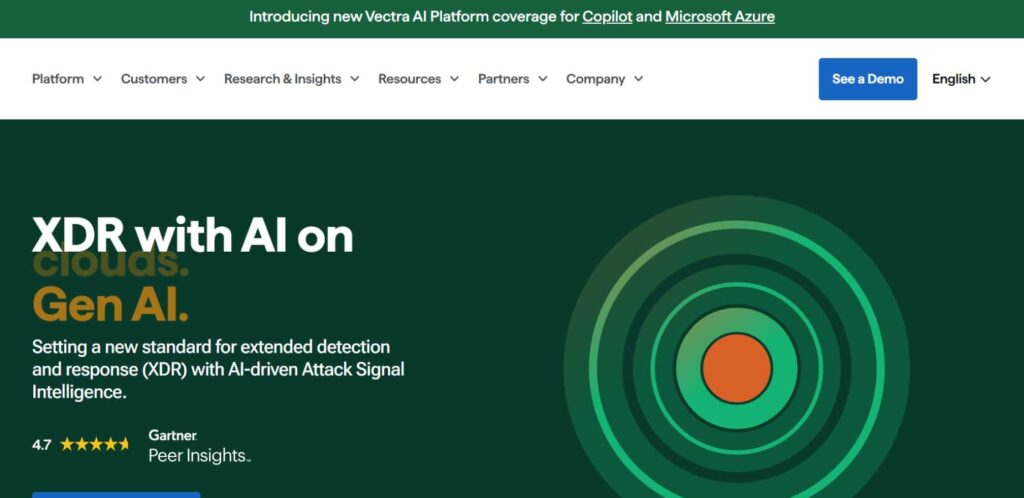
Vectra AI offers artificial intelligence in cybersecurity to offer solutions in network threat detection and behaviour analysis. One primary capability the platform has is to assist an organization in detecting and reporting APTs and other malicious activity on its network. Vectra’s technology is based on machine learning that deciphers network traffic and identifies threats that an organisation can deal with before it is too late.
Key Features:
- Network threat detection through Artificial Intelligence
- Malware control through behaviour analysis
- Identification of advanced persistent threats (APTs) in real-time
- Real-time close monitoring and identification of network abnormalities
Positives:
- Identification of concealed adversaries as well as advanced persistent threats
- Gives an understanding of the network usage
- Supportive of large Network infrastructures.
Negatives:
- Is largely designed for the protection of the network while offering very little in terms of endpoint security
- Costs may be a little bit steep for some smaller organizations
- May need integration with other tools to get full protection and safety
Best For: Organizations with large network infrastructures need AI-driven network threat detection.
Website: www.vectra.ai
Ratings: 4.4/5
4. SentinelOne
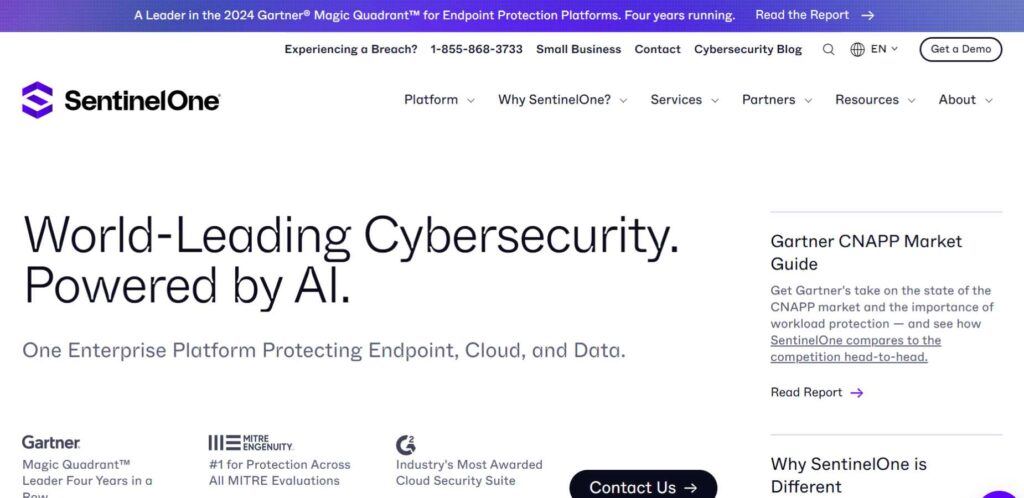
SentinelOne is an autonomous endpoint protection with an AI-driven system that detects and defends against threat agents across devices, including IoT. It stands as one of the top AI Tools for Cybersecurity, delivering real-time protection with automated response mechanisms and minimizing human intervention. Built on a robust endpoint security platform, SentinelOne offers comprehensive protection for organizations against diverse cyber threats.
Key Features:
- Endpoint security with AI-based detection and mitigation
- Live threat identification and protection
- Includes edges, clouds, and things.
- Integrating threat analysis with little to no input from a human analyst
Positives:
- Reduced or little to no automation in files and applications’ protection
- It is easy to deploy and install the solution and manage.
- For the protection against a range of cyber threats.
Negatives:
- Low visibility when it is used in specific conditions
- Adapting to the current tools can be a problem
- Some may need fine-tuning to distinguish between real and fake positive results.
Best For: Companies needing strong endpoint security with automated detection and response.
Website: www.sentinelone.com
Ratings: 4.6/5
5. IBM QRadar
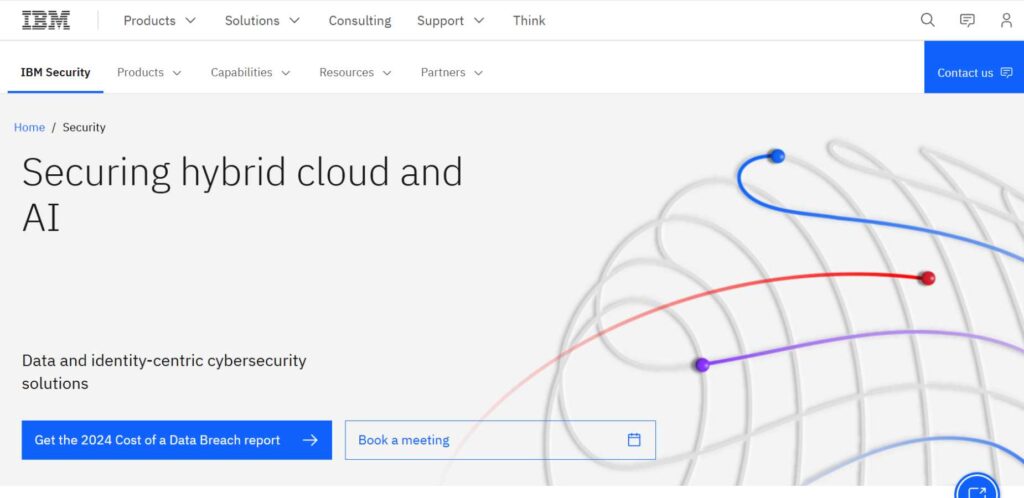
IBM QRadar is a strong SIEM solution that serves large businesses in gathering, filtering and analyzing security information. It enables an organization to identify, assess and act on emerging risks due to its prescriptive insights. QRadar has great scalability, integration and analytical plants that put it in the benchmark of preferred solutions in large and complex enterprises.
Key Features:
- SIEM Solution stands for Security Information and Event Management
- Weak Real-time threat identification and analysis
- Integrates with other tools and is flexible.
- Offers forensic and investigation services
Positives:
- High analysis and planning tools
- Suitable for large-scale enterprises
- Detects and addresses a full range of threats
Negatives:
- Difficult installation and setup
- Resource-intensive
- It may need specific security teams for its efficient implementation.
Best For: Large enterprises requiring advanced SIEM capabilities and scalable solutions.
Website: www.ibm.com/security/qradar
Ratings: 4.3/5
6. Microsoft Sentinel

Microsoft Sentinel is cloud-based SIEM and SOAR solution. As one of the a versatile AI Tools for Cybersecurity, it easily integrates with Microsoft platforms, with scalability and flexibility. It empowers organizations through advanced data analytics and automated workflows to detect and respond to threats more efficiently, focusing on optimizing security operations.
Key Features:
- Cloud-native SIEM and SOAR solution
- Working with Microsoft and other security applications
- Security intelligence, automated security management, security threats.
- Large enterprises solution
Positives:
- Some of the features of Microsoft products while working with Microsoft Excel.
- Easily scalable & adaptable engineering platform
- Powerhouse automation systems and powerful and affordable analytical services
Negatives:
- Unfamiliar with another environment other than Microsoft
- Ideal for requiring special skills of expertise to attain favorable configuration.
- It may also be costly depending on the size of the use of ad space.
Best For: Organizations heavily using Microsoft products looking for a scalable SIEM and SOAR solution.
Website: https://www.microsoft.com/en-us/security/portal/microsoft-sentinel
Ratings: 4.4/5
7. Proofpoint

Proofpoint is a Cybersecurity company that operates in the fields of email security, threat protection and data loss prevention. It shields against phishing, malware and other sophisticated e-mail-based threats, enabling organizations to secure important and confidential Data. Proofpoint is one of the best solutions to protect business email communication and has great features in the area of threat protection.
Key Features:
- Gaining email security and protection from various threats
- Protection against phishing, malicious software and loss of important data.
- A cloud-based platform with integrated threat intelligence
- Data encryption and email protection
Positives:
- Good protection from email-borne threats
- Outperforms all other methods in the ability to combat phishing incidents
- A set of advanced protection tools for data loss
Negatives:
- Email security only (does not cover all the network or endpoint)
- May prove expensive for small business organizations
- May need other security products for it to complete a security solution
Best For: Organizations needing advanced email security and threat protection.
Website: www.proofpoint.com
Ratings: 4.5/5
8. FireEye Helix

FireEye Helix described a FireEye solution that combines all these components into a single entity: SIEM, threat intelligence, and incident response. It provides performance monitoring and reporting, investigative and remediation features; thus it helps organizations quickly identify and tackle security threats. FireEye Helix is popular among businesses that desire a single security platform that provides both, advanced threat detection and response, and global threat intelligence.
Key Features:
- Hypergrowth by integrating SIEM, threat intelligence, and incident response
- In real-time, threads present outlining the identification and analysis of the threats.
- Even the forensic abilities and the threat intelligence feeds
- Security operations center
Positives:
- Integrated solution from a single platform for several security capabilities
- Good threat intelligence and effective means of incident handling
- Demand analysis for fast decision-making
Negatives:
- Very capital intensive to implement
- It can be difficult, if not impossible, to control without the right staff on board.
- Expensive to small and medium organizations
Best For: Businesses looking for a comprehensive security platform that combines SIEM, threat intelligence, and incident response.
Website: www.fireeye.com
Ratings: 4.3/5
9. Fortinet FortiAI

Fortinet FortiAI is an AI-driven SOC solution designed to automate security operations, including incident detection and response. As one of a cutting-edge AI Tools for Cybersecurity, it leverages artificial intelligence to analyze and mitigate threats faster than traditional methods. FortiAI is ideal for organizations seeking to enhance their security teams with advanced technologies for rapid threat containment.
Key Features:
- Machine-based security system for threat identification and action
- Utilization of effective techniques for the analysis and management of security threats
- Integrate with other Fortinet solutions
- A protection mode, if used across devices in real-time
Positives:
- Real-time threat detection response depends on the application of AI.
- Reduces the amount of work performed by networking professionals in security operations
- Flexibility to integrate with other products in the Fortinet family
Negatives:
- Lacks the same kinds of detailed coverage that traditional SIEM solutions can accomplish
- Expensive for small business type
- Restricted only to the company collaborating with Fortinet
Best For Organizations needing AI-driven security operations for rapid threat detection and response.
Website: www.fortinet.com
Ratings: 4.4/5
10. Palo Alto Networks Cortex XSOAR

Cortex XSOAR by Palo Alto Networks is a SOAR platform that provides automation of response and security operations. It works with numerous security solutions to offer seamless connections for automating workflows associated with threat identification and reaction. Cortex XSOAR is for large enterprises interested in efficient security operations and faster response to incidents with integrated workflows across different systems.
Key Features:
- A Security Orchestration, Automation, and Response (SOAR) platform
- Coordinates and orchestrates incident response and functions in concert with several security solutions.
- Workflow for faster threat response
- Full end-to-end reporting and analysis functionalities
Positives:
- First-rate automation and coordination tools
- Reduces the time for incident response and manual intervention
- Sits well within the broader security ecosystem and infrastructure
Negatives:
- It is difficult to establish and configure an RSS feed.
- May take a long time before one is in a position to maximize the use of this program.
- Costly to some organizations, particularly the small ones
Best For: Enterprises seeking a powerful SOAR platform for automated incident response and security orchestration.
Website: www.paloaltonetworks.com
Ratings: 4.6/5
Challenges in Implementing AI for Cybersecurity
While AI holds significant promise for the future of cybersecurity, its implementation comes with challenges:
- Data Privacy Concerns: AI in cybersecurity usually involves processing large amounts of data that can raise privacy and compliance concerns.
- False Positives: Some AI models contain an error that can sometimes mistake an item as belonging to a specific category when it is not. This puts pressure on security teams and causes more than necessary spending.
- Cost of Implementation: Since implementing AI tools requires a certain amount of infrastructure changes, the initial investment might be significant, especially for small to mid-sized businesses.
- Skill Gaps: AI adoption in cybersecurity is far from being a simple endeavour because it takes specific skills to handle and operate an AI system within an organization’s security framework, especially since many organizations might not have the human resources required to handle and optimize the AI systems.
The Future of AI in Cybersecurity
As AI continues to evolve, its role in cybersecurity is expected to become even more integral. Future advancements in AI could lead to:
- Improved Threat Intelligence: AI systems will continue to improve sophistication in the evaluation of threat data from all over the world, giving a better understanding of new threats and attack profiles.
- More Effective Automation: The threat response experience will grow more intelligent with time, allowing for better autonomous responses while also avoiding unnecessary information processing.
- Smarter Decision-Making: As AI tools advance, these intelligent tools will be able to make more appropriate decisions about when to escalate threats, when to respond, and when to cooperate with other security systems.
It is without a doubt that cybersecurity is, and will continue to depend on developments in AI technologies and the organizations that incorporate the use of AI tools as their assets have a competitive edge over those that do not.
Conclusion
The integration of Artificial intelligence in the cybersecurity industry is becoming more prominent as it redesigns how organizations protect against cyber incidents. Due to its efficiency in handling a huge amount of data, AI enables threat detection and prevention in real-time, an aspect that classic tools cannot offer. The following ten AI Tools for Cybersecurity show how companies manage modern threats effectively, utilizing the best-of-the-breed technology.
By taking advantage of these AI technologies, organizations will be in a position to fortify their protective measures, thereby reducing potential threats and guaranteeing the security of their networks and data in the wake of the complex and sinister world today.
As cybersecurity threats become more sophisticated, embracing AI Tools for Cybersecurity will be essential for businesses aiming to stay secure and resilient.
Frequently Asked Questions (FAQs)
How does AI help to improve threat identification in real-time operations?
AI increases real-time threat identification since it processes voluminous network traffic, users’ interactions, or system logs. Unlike other instruments that work based on patterns that recognize their signatures, AI can detect previously unidentified threats as it responds to deviations from normalcy.
Is AI capable of solving all forms of cyber threats?
AI security works well for most everyday dangers, including malware and phishing, but a digital entity might not be certain to handle highly advanced and intricate attacks. Consequently, in this case, the machine learning algorithm of the AI outperforms the human skills of comprehending and identifying a new threat or threat pattern.
Should small businesses avoid AI due to high costs?
Small businesses often consider acquiring AI solutions expensive, initially, but the cost/Benefit analysis usually indicates that the benefits of having an AI assistance system include lower security threats, faster response, and a more efficient system. In the future AI technology may develop to be more affordable and easier for any business to incorporate.
In what ways does AI prevent human errors in cyberspace?
Reduction of error, one of the major factors that motivate the use of AI in the analysis of logs and threats, is a result of the elimination of manual operations such as those below. It also helps avoid situations where due to tiredness or inattention mistakes are made when performing security tasks, letting the security team investigate more complicated cases instead.
What are the challenges that are likely to arise when using AI in cybersecurity?
Likely limitations of AI are; Some vulnerability issues affecting data security, improper labelling or false alarms whereby real traffic is detected as a threat, expensive initial costs required to incorporate AI and also technical expertise in making necessary arrangements for AI.

